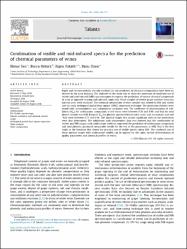| dc.contributor.author | Şen, İlknur | |
| dc.contributor.author | Öztürk, Burcu | |
| dc.contributor.author | Tokatlı, Figen | |
| dc.contributor.author | Özen, Banu | |
| dc.date.accessioned | 2022-05-11T14:47:28Z | |
| dc.date.available | 2022-05-11T14:47:28Z | |
| dc.date.issued | 2016 | |
| dc.identifier.issn | 0039-9140 | |
| dc.identifier.issn | 1873-3573 | |
| dc.identifier.uri | https://doi.org/10.1016/j.talanta.2016.08.057 | |
| dc.identifier.uri | https://hdl.handle.net/20.500.11776/10500 | |
| dc.description.abstract | Rapid and environmentally friendly methods for the prediction of chemical compositions have been an interest in the wine industry. The objective of the study was to show the potentials of combined use of visible and mid-infrared (MIR) spectroscopies to improve the prediction of various chemical compounds of wine as opposed to using mid-infrared range only. Wine samples of twelve grape varieties from two harvest years were analyzed. The chemical composition of wine samples was related to MIR and visible spectra using orthogonal partial least square (OPLS) regression technique. The prediction abilities were tested with crossvalidation and independent validation sets. The coefficient of determination of validation (R-val(2)) for anthocyanin compounds of red wines were between 0.76 and 0.90, and that for total phenol content was 0.90. Range of R-val(2) for glycerol, glycerol/ethanol ratio, malic acid, o-coumaric acid and degrees Brix were between 0.77 and 0.96. The spectral ranges that played significant roles in the predictions were also determined. The validations with independent data sets showed that the combination of visible and MIR ranges with multivariate methods improved the prediction of anthocyanin compounds and total phenols; produced comparable results for the rest of the parameters as MIR. This is the first study in the literature that shows the practical use of visible spectra along MIR. The combined use of these spectral ranges with multivariate models can be applied for the rapid, on-line determination of quality parameters and chemical profiles of wines. (C) 2016 Elsevier B.V. All rights reserved. | en_US |
| dc.description.sponsorship | Izmir Institute of TechnologyIzmir Institute of Technology [2010IYTE07] | en_US |
| dc.description.sponsorship | This research was supported by the Scientific Research Project of Izmir Institute of Technology (2010IYTE07). | en_US |
| dc.language.iso | eng | en_US |
| dc.publisher | Elsevier Science Bv | en_US |
| dc.identifier.doi | 10.1016/j.talanta.2016.08.057 | |
| dc.rights | info:eu-repo/semantics/openAccess | en_US |
| dc.subject | Anthocyanins | en_US |
| dc.subject | UV-Visible spectroscopy | en_US |
| dc.subject | Fourier transform mid-infrared spectroscopy | en_US |
| dc.subject | Orthogonal partial least square regression | en_US |
| dc.subject | Wine analysis | en_US |
| dc.subject | Wine composition | en_US |
| dc.subject | Ft-Mir | en_US |
| dc.subject | Infrared-Spectroscopy | en_US |
| dc.subject | Quality Assessment | en_US |
| dc.subject | Red Wines | en_US |
| dc.subject | Grape | en_US |
| dc.subject | Chemometrics | en_US |
| dc.subject | Anthocyanins | en_US |
| dc.subject | Spectrometry | en_US |
| dc.subject | Feasibility | en_US |
| dc.subject | Profiles | en_US |
| dc.title | Combination of visible and mid-infrared spectra for the prediction of chemical parameters of wines | en_US |
| dc.type | article | en_US |
| dc.relation.ispartof | Talanta | en_US |
| dc.department | Meslek Yüksekokulları, Şarköy Meslek Yüksekokulu, Gıda İşleme Bölümü | en_US |
| dc.authorid | 0000-0002-0428-320X | |
| dc.authorid | 0000-0003-0123-2236 | |
| dc.authorid | 0000-0003-2643-5523 | |
| dc.identifier.volume | 161 | en_US |
| dc.identifier.startpage | 130 | en_US |
| dc.identifier.endpage | 137 | en_US |
| dc.institutionauthor | Öztürk, Burcu | |
| dc.relation.publicationcategory | Makale - Uluslararası Hakemli Dergi - Kurum Öğretim Elemanı | en_US |
| dc.authorscopusid | 55817507800 | |
| dc.authorscopusid | 55110763700 | |
| dc.authorscopusid | 23101457000 | |
| dc.authorscopusid | 6603013605 | |
| dc.authorwosid | Özen, Banu/D-7493-2013 | |
| dc.authorwosid | ÖZTÜRK, Burcu/ABA-4521-2020 | |
| dc.authorwosid | Tokatli, F./B-6746-2012 | |
| dc.identifier.wos | WOS:000386989500018 | en_US |
| dc.identifier.scopus | 2-s2.0-84983380706 | en_US |
| dc.identifier.pmid | 27769388 | en_US |



















